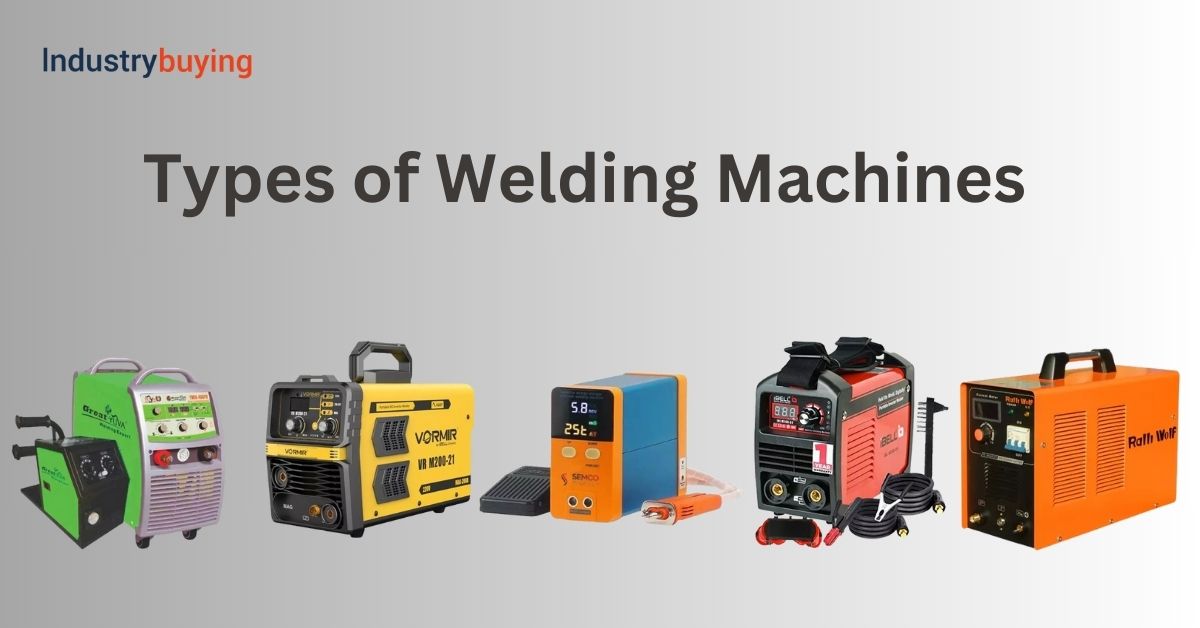10 Different Types of Welding Machines

Last Updated on November 4, 2024
Welding machines are used to join metal or other materials to make welds. These machines are classified on the basis of the mechanism they follow to make welds. You will find vast applications for welding machines in the construction, manufacturing, plumping, automotive, and other industries. There are different types of welding machines on the market, and they have specific characteristics, advantages, and disadvantages. We have listed the top 10 types of welders best suited for your business requirements.
Types of Welding Machines
- MIG Welding Machine
- TIG Welding Machine
- Stick Welding Machine
- Flux-Cored Arc Welding Machine
- Plasma Arc Welding Machine
- Laser Welding Machine
- Energy Beam Welding Machine
- Submerged Arc Welding (SAW) Machine
- Oxyacetylene Gas Welding Machine
- Atomic Hydrogen Welding Machine
1. MIG (Metal Inert Gas) Welding Machine
Metal inert gas welding machines are the most widely used welding machines. The working of the MIG welder involves a continuous electrode wire fed through a welding gun, which is shielded by an inert gas.
Advantages:
- It is a high-speed welding machine.
- It is easy to handle and use.
- Produces clean and precise welds.
Disadvantages:
- It needs an external gas supply.
- It has minimal effect on rusty or dirty materials.
Suitability
- It is used to weld materials like carbon, steel, & aluminium.
- It is suitable for workshops at offices & homes.
- Used in automotive, construction, robotics, etc industries.
2. TIG Welding Machine
TIG stands for Tungsten Inert Gas. TIG welders use a non-consumable tungsten electrode with an independent filler material. It is known for its precision and quality of welding. It is used to weld aluminium, steel, nickel, titanium, manganese, brass, copper and bronze.
Advantages:
- The welds produced are precise, clean, and high-quality.
- Work well with thin & delicate materials.
Disadvantages:
- Welding speed is slow.
- It requires skilled personnel for welding.
Suitability
- It is used to repair bike parts, door handles, and lawnmowers.
- It is used for welding in piping, aerospace, automobile, fabrication, and artwork industries.
3. Stick Welding Machine
It is also known as a shielded metal arc welding machine. The working of a stick welding machine involves generating heat by passing an electric current in between a base metal and a filler rod. The filler rod is coated with a flux to prevent contamination by producing CO2 gas.
Advantages:
- It is simple and portable.
- It can handle harsh weather conditions.
- It does not need external shielding gas.
Disadvantages:
- It produces higher spatter, leading to post-weld cleanup.
- It requires more skill for neat welds.
Suitability
- It is more suitable for outdoor use.
- It is applied in pipeline welding, farm tools repairs, the steel industry, etc.
4. Flux-Cored Arc Welding (FCAW) Machine
Instead of a solid electrode wire, FCAW welders use a flux-coated electrode that is continuously fed. Due to the flux coating, these welders do not require an inert gas for shielding. FCAW welders are suitable for both indoor and outdoor use.
Advantages:
- Produces clean welds with a high deposition rate.
- Suitable for welding thick materials.
Disadvantages:
- It is costly compared to other welding machines
- Not easy to handle
Suitability
- Suitable for welding carbon steels, inox steel, cast iron, and nickel-based alloys.
- Applied in construction and fabrication industries.
5. Plasma Arc Welding Machine
PAW welding machines are also called Plasma Transferred Stick welding machines. It consists of an anode that surrounds the tungsten electrode. The anode acts as a shielding gas similar to that in TIG welders. PTAW welders are used to weld thicker materials.
Advantages:
- It produces clean and precise welds.
- Works at a high welding speed.
- There are minimum heat-affected areas.
Disadvantages:
- It is an expensive welding machine.
- Requires skilled operators for welding.
Suitability
- Suitable for manufacturing industries.
- Suitable for large-scale welding processes.
6. Laser Welding Machine
Laser welding machines use fibre laser beams to make welds. With laser technology, welding has become automated, fast, easy to handle, and inexpensive. It is vastly applied in the aerospace and automotive industries.
Advantages:
- It offers high precision and accuracy.
- Produces minimal distortion and heat-affected zone.
Disadvantages:
- The initial cost is high.
- Limited to thin and delicate materials.
Suitability
- Vastly applied in automotive and aerospace industries.
7. Energy Beam Welding Machine
Energy beam welders are also known as electron beam welding machines. These welders use magnetic fields to focus a strong beam of electrons on the base material. The electron beam is vacuumed to prevent any absorption from the atmosphere. It can be used to fuse two different materials.
Advantages:
- It produces minimal heat distortion on welded surfaces.
- It offers versatile applications.
- It is a cost-effective welding machine.
Disadvantages:
- Not suitable for home applications.
Suitability
- It can be used to meld thin into thick materials.
- Widely applied in medical, defence, automotive, oil and gas, etc, industries.
8. Submerged Arc Welding (SAW) Machine
It uses a reusable powder flux instead of a gas shield to generate an electric arc between a continuously fed electrode and a workpiece. It is available in both automatic and semi-automatic modes. These welders are mostly applicable in large-scale industries.
Advantages:
- High welding speed and deposition rate.
- Excellent weld quality.
- Minimal spatter and fumes.
Disadvantages:
- It is limited to horizontal or flat welds.
- It requires flux handling and recovery.
Suitability
- It is suitable for welding thick materials.
- Works well with stainless steel, nickel & steel alloys.
9. Oxyacetylene Gas Welding Machine
Oxyacetylene welders use acetylene and oxygen to generate heat and melt base metal to create welds. These welders are suitable for thin materials. The welding temperature can be controlled by adjusting the oxygen-fuel ratio on the machine.
Advantages:
- It is an easy-to-handle and portable welder.
- It is a low-cost welding machine.
Disadvantages:
- Restricted to ferrous materials.
- It is not suitable for thick materials.
Suitability
- Applied in fabrication, plumbing, and automotive industries.
10. Atomic Hydrogen Welding Machine
AHW welders use two tungsten electrodes to generate an arc and are shielded by an external hydrogen-shielded gas cylinder. It dissociates the hydrogen molecule into atomic form to create welds.
Advantages:
- It offers high precision and accuracy.
- It produces strong and clean welds.
Disadvantages:
- It’s costlier than MIG welders.
- It should be handled by skilled personnel.
Suitability
- Suitable for thin materials that are difficult to weld with gas welders.
- Compatible with stainless steel, ferrous & non-ferrous metals, and alloys.
Conclusion
- By now, you know how many types of welding machines are available in the market. Plus, you know their features, advantages and disadvantages.
- Now, choose the one that suits your business requirements. Consider the factors such as the welding speed, materials to be welded, portability, handling, etc.
- Since each welding machine can serve multiple industries, if you are working with different industries, choose the one that suits multiple projects.
At Industrybuying, you can find a wide range of different types of welding machines. Contact our experts if you need help making the right choice.
FAQs
Welding machines are classified according to their mode of operation, the materials they can weld, the electrode or inert gas used, etc. The different types of welding machines are MIG, TIG, Spot, Stick, Flux-cored Arc, Plasma Arc, Laser, Electron Beam, SAW, etc. Each welding machine has advantages and disadvantages that you must consider before buying one.
MIG or Metal Inert Gas welding machines are the most commonly used. They are beginner-friendly and easy to handle. MIG welders can be used on a variety of materials. However, a TIG welding machine is recommended for aluminium or non-ferrous materials. Before buying a welding machine, you must consider material, power consumption, cost, etc.
Both machines are used for welding but differ in their operation mode. A MIG welding machine uses an electrode wire continuously fed and shielded by an inert gas. Meanwhile, a TIG welder uses a tungsten electrode with a separate filler material. MIG welding machines are easy to handle; however, TIG welding machines offer more precision.
Choosing the right welding machine depends on your business or project needs. You must consider factors such as the material to be welded, precision, power requirements, portability, electrode used, shielding gas required and budget considerations.

